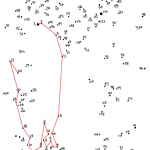 I was a big fan of Sherlock Holmes and various other fictional detectives growing up; I’m still drawn to the form when I want to relax. There’s a basic pleasure in trying to match wits with Sherlock and figure our who the killer is before the final reveal. Connecting the dots is a rewarding game but it’s a flawed strategy.
I was a big fan of Sherlock Holmes and various other fictional detectives growing up; I’m still drawn to the form when I want to relax. There’s a basic pleasure in trying to match wits with Sherlock and figure our who the killer is before the final reveal. Connecting the dots is a rewarding game but it’s a flawed strategy.
The picture is always clear after the fact. But to jump from that fact to the assumption that you can recognize the dots earlier and connect them into one single, compelling, inarguable picture that triggers right action is a leap too far. Detective stories have an advantage that truth lacks; the writer knows where they intend to go.
The problem is that connecting the dots is such a well worn story telling and story organizing technique. The key to using this as a story telling technique is to manage the ratio of story dots and noise dots. Looking backward to make sense of the outcome that came to pass, the storyteller emphasizes the dots that reveal the picture and shares just enough other dots to suggest the work our hero had to do to see the hidden picture. As a good storyteller you might add a clever twist or put our hero in just the right spot to see what others have missed.
Suppose, however, that in the real world our potential hero was looking in the wrong direction or trying to separate the relevant dot from a thousand irrelevant but similar dots. Now our hero might be portrayed as a fool or an incompetent. Our hero’s reputation and future hangs on the objectives of the storyteller, not on the events in the field.
The appeal of the connecting the dots rhetorical strategy obscures its flaws as a thinking strategy. There are two principal flaws from a problem-solving perspective. One, it suggests there is a single, correct, picture of what is going on waiting to be discovered as soon as someone draws the correct thread through the data points that otherwise appear to be noise. Two, it presumes that recognizing the picture offers sufficient, timely, insight into appropriate action steps.
There are always too many dots; in a big data world we seek more dots in the hope that the picture will emerge. All the analytical tools will do, however, is add more possible pictures that might be hiding in the dots. Any collection of dots might form multiple pictures; more dots simply suggest more pictures.
Which brings us to the second problem; how does recognizing a picture connect to effective response? In our detective stories, our goal is to bring the killer to justice, perhaps to intervene before the killer strikes again.
In the world of more dots than time, our goal is to devise a response soon enough to make a difference. We wish to create a new story to be told. The dots behind us are only useful in suggesting where to place the dots that are not yet part of the picture we are in the act of creating.
When it starts raining, we can’t know when it will stop or what intensity to expect. I love your distinction between rhetoric and the realtime dots and data points. Today data, like rain may arrive from any direction, in any quantity and for any duration. Precisely why another strategy or at least, model for your expectations is beneficial. The sensor pattern, when shared, may tip others to act when the rain hits!